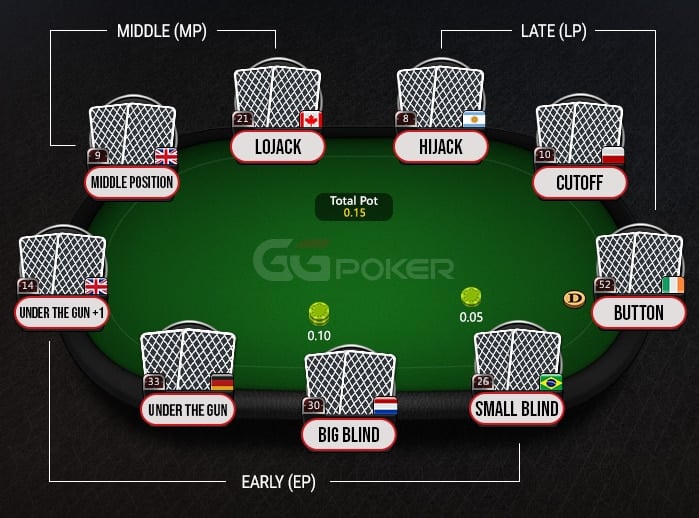The Cutoff

Understanding the strategic nuances of poker positions can markedly improve your gameplay, and few positions offer as much potential leverage as ‘the cutoff’. Today, we’ll dive into what the cutoff position is, why it’s so crucial, and start you on a journey to learn how you can maximize its advantages to enhance your poker prowess.
What is the Cutoff in Poker?
In the landscape of a poker table, particularly at a nine-handed table, each position holds its unique characteristics and strategic implications. Here’s a quick breakdown:

The cutoff is the seat right to the left of the dealer button. This placement is strategic, as the dealer button is the most coveted position due to its advantageous post-flop acting sequence. The rotation of the dealer button moves clockwise, ensuring that each player experiences every position, including the cutoff, once every orbit.
Origins of the Name ‘Cutoff’
The origins of the term ‘cutoff’ might not be crystal clear, with various theories floating around. One practical explanation suggests that in home games, the player in this position often had the responsibility of cutting the deck after the shuffle—hence the term ‘cutoff’. Another more tactical interpretation is that this position can ‘cut off’ the dealer’s potential to dominate the game by acting just before them, thereby interrupting their strategic advantage.
Advantages of Playing from the Cutoff
The cutoff is considered one of the most advantageous positions in poker due to its strategic flexibility. Here’s why:
- Late Position Benefit: Acting late in the round (just before the dealer) means you can observe the actions and reactions of most other players before you have to make your move. This information can be crucial in formulating your strategy.
- Opportunity to Steal Blinds: If the action folds to you in the cutoff, you have a prime opportunity to raise and potentially steal the blinds. This move can pressure the button and the blinds, putting you in a controlling position.
- Wide Range Opening: With fewer players left to act after you, you can afford to open a wider range of hands. This wider range increases your chances of picking up the blinds uncontested.
- Post-flop Positional Advantage: Should your raise not clear the field, you are still guaranteed to act last in all subsequent betting rounds post-flop, provided the button has folded. This advantage allows you to make more informed decisions based on the complete action of the hand.
Player Profiles and Adaptation: Tailoring Cutoff Strategy
Understanding different player types is crucial when adapting your strategy from the cutoff. Recognizing whether opponents are tight, loose, aggressive, or passive allows you to make more informed decisions and adjust your play to maximize your edge.
Tight Players: Against tight players, who often fold unless they have strong hands, expanding your opening range from the cutoff can be highly effective. Tight players are less likely to challenge your raises without premium hands, offering you a greater chance to steal the blinds. However, if a tight player re-raises, it’s generally wise to proceed with caution.
Loose Players: When facing loose players, who tend to play a wider range of hands, it’s important to tighten up your opening range. Since these players are involved in more pots, the likelihood of them calling your raises increases. Focus on playing quality hands that perform well in post-flop play, as you’ll often need to navigate more complex scenarios against them.
Aggressive Players: Aggressive opponents can be challenging from the cutoff. They often re-raise and apply pressure, trying to seize control of the pot early. When dealing with aggressive players, balance your strategy between calling their bluffs and folding when the risks outweigh potential gains. Use their aggression against them by letting them build the pot when you hold strong hands.
Passive Players: Passive players rarely initiate action, giving you more leeway to control the game’s pace from the cutoff. Against such opponents, feel free to open a wider range of hands and apply pressure post-flop. Since passive players are less likely to bet or raise, you can more safely bluff and manipulate pot sizes according to the strength of your hand.

Adjusting to Opponent Tendencies
Beyond recognizing player types, observing specific tendencies and patterns can further refine your cutoff strategy. Pay close attention to how each player reacts to different situations, and adjust your play to exploit their habitual decision-making. Effective adaptation involves not just playing your cards but playing the players, a nuanced skill that combines keen observation with strategic execution.
Navigating Challenges from the Cutoff
Despite its advantages, the cutoff isn’t without challenges, primarily from the button. The player in the button position has the ultimate advantage of acting last post-flop and can exploit any perceived weaknesses if you’re too liberal with your cutoff raises. Effective cutoff play involves a delicate balance; you must be aggressive enough to utilize the position’s inherent advantages but also cautious not to overplay your hand, especially against a savvy button player.
Conclusion
Playing from the cutoff can significantly influence the dynamics of your poker game. By understanding the strategic value of this position and implementing thoughtful play, you not only enhance your chances of winning the current hand but also increase your overall table image and pressure-handling capabilities. Embrace the cutoff’s potential, and watch as your poker game reaches new heights of sophistication and success. Whether it’s seizing the opportunity to steal the blinds or crafting a cunning post-flop play, mastering the cutoff is a surefire way to elevate your poker prowess.





